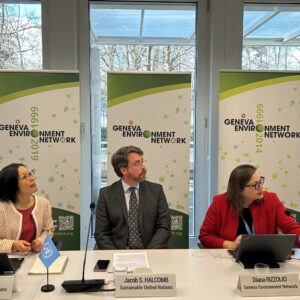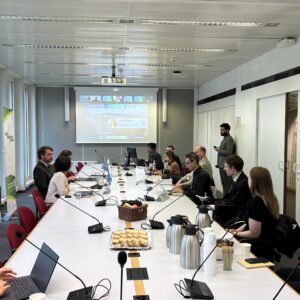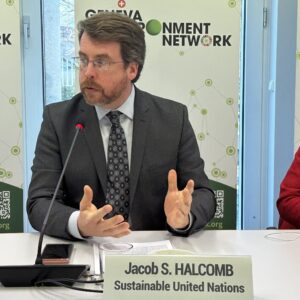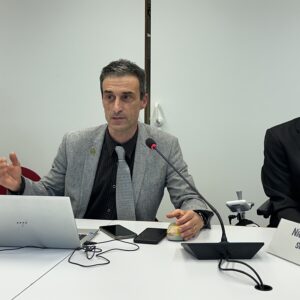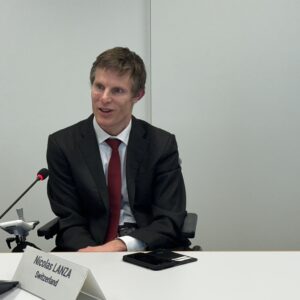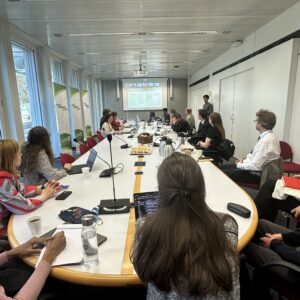Event Conference
The UN System’s Environmental Footprint | Findings of the Greening the Blue Report 2023
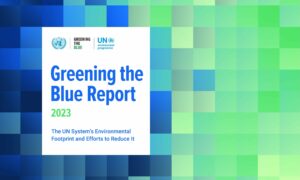
25 Jan 2024
15:30–17:00
Venue: International Environment House I, Room 2 & Online | Webex
Organization: Sustainable United Nations, Geneva Environment Network
The UN system is making steady progress towards reducing its environmental footprint. This session presented the 2023 edition of the Greening the Blue Report.
About this Session
In this event, the United Nations Environment Programme (UNEP) presented the 2023 edition of the Greening the Blue report, which includes 2022 data. The report presents the environmental impacts of 57 entities from across the UN system and beyond, employing over 308,000 personnel in Headquarters, field offices and in operations on the ground.
A panel of representatives from different UN Entities brought concrete examples of their efforts to improve their environmental performance, including efforts on implementing environmental management, solarization, and reduction of plastic use. These efforts show how the UN system is walking the talk toward achieving the commitments of the Strategy for Sustainability Management in the United Nations System 2020 – 2030.
Greening the Blue
Greening the Blue is a UN-wide initiative to engage and support UN system personnel in integrating environmental considerations into UN management decisions and activities. The annual Greening the Blue report provides information on the environmental footprint of the United Nations and the efforts to reduce it. Greening the Blue is managed by UNEP’s Sustainable United Nations (SUN) Facility. SUN supports UN Entities in measuring environmental performance, reducing impacts and offsetting their unavoidable greenhouse gas emissions.
Through a set of key performance indicators, that is being improved every year, SUN tracks and presents progress in critical areas regarding operations (such as air pollution, waste, GHG emissions, biodiversity and water) as well as management functions (environmental governance, procurement, and human resources). A collection of good practices by different UN Entities is included in the report.
Speakers
By order of intervention.

Rie TSUTSUMI
Coordinator, Sustainable United Nations, UN Environment Programme

Bethany PADFIELD
Communications Consultant, Sustainable United Nations

Agnès LOSTIS
Environmental Project Manager | Greening the Blue Focal Point, World Intellectual Property Organization
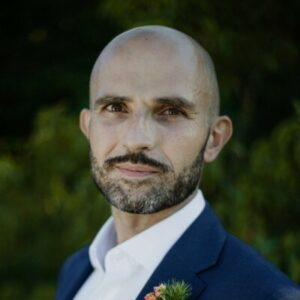
Adam OSTASZEWSKI
Energy Data Officer, International Organization for Migration

Dominic GRACE
Deputy Director, Finance and Admin Department, Head of Global Mobility and Infrastructure Services, United Nations High Commissioner for Refugees

Jacob S. HALCOMB
Programme Officer, Sustainable United Nations | Moderator
Summary
Rie TSUTSUMI | Coordinator, Sustainable United Nations, UN Environment Programme
- Greening the Blue is a UN-wide initiative that engages and supports the personnel at all levels of the organization in the transition to integrate environmental consideration into UN management decisions and actions.
- The Greening the Blue initiative is managed by the United Nations Environment Programme Sustainable United Nations (SUN) Facility.
- SUN assists UN system entities in measuring their environmental performance and reducing their environmental impact, which includes greenhouse gas emissions, reduction of waste, water use, wastewater treatment as well as biodiversity-related issues and pollution indicators.
Bethany PADFIELD | Communications Consultant, Sustainable United Nations
- The 2023 edition of the Greening the Blue Report provides data from 2022. The data covers the environmental impact areas and management functions that are identified in the strategy for sustainability management in the United Nations System 2020-2030.
- This edition of the report highlights the environmental impacts of approximately 308,000 personnel and 57 reporting entities across headquarters, field offices, and operations on the ground across the globe.
- Key findings of the 2023 Greening the Blue report:
- UN operations and Facilities emitted 1.4 million tons of CO2 equivalent in total / 4.6 tons CO2 equivalent per capita.
- Seven UN entities have now met or exceeded the criteria for implementing an environmental management system. Unlike other areas of the sustainability strategy, the date for implementing the EMS at the entity level is 2025.
- Thirty-one entities have environmental training available for staff.
- The average waste generated for the whole UN system was 321 kilograms per person.
Greenhouse Gas Emissions
- Greenhouse gas emissions are more accurately detailed in the report. It shows what the main sources of emissions were and breaks these down into air travel, facilities and other travel.
- The Greening the Blue Report also shows the breakdown as the share of the total emissions by the entity. The UN Secretariat represents the largest portion of GHG emissions. 92% of these unavoidable GHG emissions were offset.
- As the UN Secretariat represents over half of the GHG emissions of the UN System, additional information is provided and broken down into more details. A detailed table breaking down some of the other areas of their environmental impacts shows the emissions by entities that fall under the UN Secretariat. The greatest proportion comes from peacekeeping and special political missions which represent 87% of the UN Secretariat’s total.
Waste
- An average of 321 kilograms per person was produced in 2022. This data is also broken down removing the impact of peacekeeping and special political missions as these are quite different from all other entities since personnel lives in UN facilities 24/7.
- The report shows that the percentage of waste from construction projects varies quite a bit from year to year as to whether there were major construction projects undertaken or not in that year.
Air Pollution
- The UN system used approximately 300 million liters of fuel in 2022. Improving the reporting around the refrigerant use in UN offices is one of the big challenges because UN entities have poor access to information on the kind of refrigerants they are using.
Water
- The annual UN Personnel water consumption was 49 meters cube. 4% of the water consumed by the UN system is recycled. Part of this area needs improvement around reporting.
Biodiversity
- While better reporting and better systems for reporting are still under development, work has been ongoing to reach a level that makes sense for all UN entities to begin reporting on biodiversity.
- Work thus far includes the UN common approach to biodiversity adopted in 2021. In 2023, a piling process for entity-level reporting on screening for biodiversity impacts was initiated. Early results on the entities that were able to participate in the piloting process are now available, and we will start implementing that across the UN system to get reports from all entities.
Environmental Governance
- The target date for Implementing Environmental Management Systems at the entity level is 2025.
- The SUN team and various entities began working at it and it is now possible to show the improvements year-over-year starting in 2020. Data show steady progress toward implementation but more work is necessary.
Procurement
- Covered under the sustainability strategy, as the UN procurement team already collects this information, that information is used in the annual statistical report on the UN nation’s procurement and the Greening the Blue Report.
- Steady improvement has been happening year-over-year, and data is being used in the report to try to show the difference from year to year to give it a bit more context.
Q: Are there any other challenges in reporting or data collection availability or measurements besides those related to refrigerants?
Bethany PADFIELD
- Reporting poses numerous challenges that depend on entity capacity. Entities have different levels of support and sizes, be that number of personnel, the number of offices in different locations around the world. trying to get a level of reporting to which all entities are enabled to give to us to the report is an ongoing challenge.
- This sustainability strategy itself was endorsed in 2019 and we started reporting on it in 2020, therefore some of the current challenges related to how to translate written strategy into real actions, the metrics to use, and so on. Nevertheless, we notice quite a few improvements year-by-year.
Lovisa SELANDER | UN Environmental Inventory Consultant, Sustainable United Nations
- The Greening the Blue inventory covers greenhouse gas emissions, water and waste. Data is collected from all UN facilities worldwide.
- In terms of greenhouse gas emissions, we collect data on scopes one and two of the Greenhouse Gas Protocol, which encompasses all emissions resulting from buildings and fleets, and then also look at scope three emissions from travel.
- Data on GHG is the oldest part of the inventory we have been collecting. Data quality for GHG emissions is quite advanced: we have great participation from UN entities and good support from facilities also in their field offices.
- Since we have been collecting this data and calculating the results for quite some time, we also have a methodology in place to make good estimates and proxies if for some reason data is not available for a year or two.
- Water and waste are newer areas for us, they were introduced later and there we are still looking at how to improve data collection. Currently, some facilities are not able to provide us with data on water and waste but also that improves every year.
Q: Did or could you consider also the travels of the people who come to the meetings that are being organized within the agencies? What would be the share would it be important as compared to what is presently given as results for travels?
Asa Elisabeth | Sustainable United Nations
- Yes. The Green Events Tool is publicly available and allows organizers to add meeting participants and calculate the emissions for both accommodation and travel to the meeting. The UN system already includes emissions of funded participants.
Lovisa SELANDER | UN Environmental Inventory Consultant, Sustainable United Nations
- There are already a few UN entities that are looking at reporting on this aspect on a more voluntary basis. This would be outside of the formal boundaries of the inventory that we make but they do still calculate the greenhouse gas emissions related to travel for meeting participants that are not sponsored by the UN system but attend UN meetings and conferences. There is an interest from some UN entities already and engagement in these issues.
Adam OSTASZEWSKI | Energy Data Officer, International Organization for Migration
- IOM’s mission is to ensure the orderly and human management of migration and that includes a mandate of protection, looking for solutions to migration problems, and providing humanitarian assistance when needed.
- We are operating in 174 countries, over 550 locations, all presenting different situations such as health migrants, health assessments centers, temporary reception centers, border crossings and so on.
- IOM staff has been growing over the past few years in response to increasing migration crises relating to various issues around conflict, natural disasters and increasingly climate change.
- Our emissions per capita have been reducing over the past few years and currently amount to about 2.6 tons per person per year, which is lower than the UN system-wide average by four tons.
Decarbonization Activities
Healthcare facilities
- In a project conducted in Mindanao, Philippines, where healthcare facilities tend to be underpowered the impact on the community is very significant. Thanks to the financial support of the government of Japan, IOM managed to enact the solarization of six healthcare facilities. It was a challenging project because of the remote accessibility and due to the COVID-19 situation.
- We were able to develop a remote training program to train our staff to do energy audits remotely. This resulted in the creation of a training program and a standardized energy assessment, shared with other humanitarian organizations.
Innovative Solutions and Humanitarian Hubs
- In a project in Malakal, South Sudan, IOM manages a very large humanitarian hub that shelters over a thousand humanitarian aid workers from over 35 different organizations. This hub provides safe accommodation, safe working space as well as Internet and phone connectivity to thousands of aid workers year round and it is a very important resource for the community taking into account again the difficulty to access in displacement areas.
- An innovative solution we were able to employ was the innovative financing mechanism called the Peace Renewable Energy Credit, developed by Energy Peace Partners. By using this type of financing mechanism, we were able to generate additional capital which was used to fund the solarization of a nearby teaching hospital.
- The longer we stay and provide renewable energy, switching from diesel energy to solar energy systems and providing clean energy in conflict-affected areas, the easier we will be eligible for additional transactions, which means additional capital. In 2023 there was a second transaction was completed which was used to support the solar electrification of the Bore State Hospital.
Decarbonization in Border Management Facilities
- IOM operates several border facilities worldwide, including airports. Some of these facilities are jointly managed by IOM and local national military, as in Jordan. The country also grappling with fuel supply issues and rising costs, and we face challenges. Typically, we rely on diesel generators in these remote and hard-to-reach areas. However, as fuel prices soar, it strains our operating budgets and introduces uncertainty about fuel supply.
- IOM manages nine humanitarian hubs across Northern Nigeria. These crucial hubs have predominantly relied on diesel fuel to sustain their operations.
- In 2022, fuel prices started soaring, complicating even further the flow of diesel into these locations. Considering these challenges, this contexts was a natural fit for solarization. Through economic and financial analyses it resulted that the results of such solarization would be visible in around four years. To enact such a process, various steps are necessary
- Energy needs assessment. It entails looking at what the biggest uses of energy are. In the case of these accommodations in Nigeria, cooling makes up over 70% of the load.
- Implement Energy Efficiency. The lowest cost of energy available is energy conservation and energy efficiency. We try to implement energy efficiency strategies before moving on to renewable energy systems and replacing diesel with renewables. This requires some staff behavior changing, educating staff on sound energy management practices, shifting and replacing some of our appliances with more efficient ones, looking at the procurement process when we are replacing some significant appliances making sure that we are looking at the total cost of ownership and not just taking procuring the one that has the cheapest upfront cost but rather looking at how much energy it consumes in total, and doing a regular management of the critical load.
- Understanding renewable energy options. Taking steps such as comparing grid-connected sites to off-grid sites; battery storage evaluation and system design assessment. Before submitting it to a community, we do a technical and financial analysis to understand what our primary needs are in terms of energy and to estimate what the system looks like.
- Manage and maintain energy system. This is where the humanitarian system really struggles sometimes because we have seen very often traditional procurements that lead to non-performing systems, especially one year or two years after because there is a lack of proper management and maintenance and oversight. Part of this is building local capacity, but more important about ensuring that there is always a company that is contracted to ensure that the solar system is fully operational. If not there are other ways to do, this such as looking at ways to procure energy as a service.
Plastic Waste Management
- In Cox’s Bazar, Bangladesh plastic waste has been a growing problem, especially ever since the influx of migrants in 2017.
- This has led to environmental damage and risks to the surrounding waterways and natural ecosystems. It has choked waterways and roads in the already heavily congested camps and when the monsoons come, drainage systems frequently clog.
- Against this backdrop, IOM recently undertook a project to create a plastic recycling center. Today, the center processes 65 kilograms of plastic waste per day, including approximately almost 25,000 polyurethane plastic bags collected by camp residents.
- Each household has been provided with two bins for sorting their waste, one for organic waste and another one for non-biodegradable. We have empowered the community and explained the benefits of managing waste properly.
- Now that this center has been operational for some time we are taking these discarded plastic bags and other types of packaging and turning them into useful products for the community including colorful leather blocks as a learning aid for children in schools, building materials even like pavement slabs, latrine pit cover, slabs and other types of products.
Agnès LOSTIS | Environmental Project Manager | Greening the Blue Focal Point, World Intellectual Property Organization
- WIPO began its journey to carbon neutrality in 2009.
- Since 2014, WIPO has been carbon neutral through the UN Framework Convention on Climate Change compensation mechanism.
- IOM policy is based on two frameworks: the UNFCCC and the host country framework (Switzerland).
- IOM recently joined 2050Today, which helps us deal with local action and issues in Geneva.
- In 2022, we adopted a new environmental policy and now are in the stage of implementing an environmental management system to comply with the UN deadline of 2025 for the development of an EMS.
WIPO Strategic Choices
- Activities to green our impact include gardens on the roofs and more efficient lighting on the campus. The campus has been powered by the Geneva-Lac-Nations (GLN) GLN for heating since 2015.
- These choices and what we have implemented for more than 10 years have had a great impact on most of our energy consumption, especially in terms of electricity and water, where consumption has dropped by 30%.
- We try as well to manage heating and cooling as much as we can, but sometimes it is also due to a variation of weather conditions, and it is more complicated to manage but we do our best.
- Recently we have changed our heating policy, reduced heating temperature by one degree and that has been able to achieve more than 30% of energy reduction for heating.
- Greenhouse gas is also something we look at. Before the COVID-19 outbreak, travel was WIPO’s main source of environmental impact: about 60- 70% of the total greenhouse gas emissions. While important reductions occurred between 2019 – 2022, the current challenge is to keep under control emissions due to travel.
- In the journey to green organizations, what is key is to have a vision and leadership commitments. Challenges include finding the right argument to drive change. The human aspect is important as well: we need to think globally and act locally. We have to turn constraints into opportunities and try to be as innovative as we can and accept, test, and take action as much as we can.
Dominic GRACE | Deputy Director, Finance and Admin Department, Head of Global Mobility and Infrastructure Services, United Nations High Commissioner for Refugees
- Any discussion of CO2 reduction etc. needs to start with data, and this is why Greening the Blue is so critically important.We need, on an annual basis, to update where we are, oue interventions and our CO2 reductions must be based on measurement as it is only by measuring that we can manage.
- UNHCR values the Greening the Blue exercise very highly, and commits a lot of resources to meet its goals. Around 98% of our offices worldwide provide data for Greening the Blue. The benefit of this, apart from knowing exactly what our CO2 footprint is, is that it is not at a country level but it is at an office level. We saved a very tangible $62,000 because we are refining our CO2 emissions, and therefore, we spend less money on offsetting them through carbon credit purchases.
Data Collection
- Through the UNIFIER facility management system our 550+ offices worldwide can fill the data on the locations, sizes, leasing costs, staff numbers, generators, fuel storage, etc. UNIFIER allows to capture our Greening the Blue data directly into Oracle. All our offices log into Oracle and enter their data and we have trained over 550 focal points to do that. Then, we have an algorithm that runs on the data to ensure its credibility.
- We participate in the “Bring Your Own Emissions” option when it comes to Greening the Blue. We calculate our own emissions through the International Energy Agency (IEA)’s translation table that converts fleet, travel, refrigerants, etc. into CO2 and other indicators used in the Greening the Blue report,. It is very valuable for us to have a heat map and to be able to see where the problems lie so that we can target our interventions and investments in renewable energy.
- We partially automate data collection. For example, we have been using the Green Box, a system that can be clipped it onto a power system in an office and tells the amount of consumed kilowatts per hour. Information is transferred to a centralized database, allowing remote measurement and comparisons over time. We also have tracking satellite on the majority of our vehicles, so we can calculate how many kilometers they have traveled and how much fuel they have burnt. We provide our countries’ offices with their data, including how much electricity they’ve used and how many liters of fuel they have burnt during that year and they can validate that if they wish.
- We also do collaborative information sharing. In 2023, we facilitated three online workshops focusing on fleet, travel, and HQ buildings. We had a fourth session organized with counterparts in Germany, focusing on the footprint in the field, which is probably the largest single emissions for the UN family in general. So, we organized this workshop in Berlin which was very productive, and from that, we have had spin-offs: we have got a Green Box called the PCCM and a Green Box working group that talks about how we can use green boxes in other locations and engages with the supplier and manufacturer of the Green Box to optimize it.

- After data collection, data is used to implement solarization of our offices in the field. We have raised approximately $34 million so that we do not have to burden country offices with the cost.
- We have made a lot of progress, and we have several sites, on of our biggest sites is in Kakuma in Kenya which is something like 850-kilowatt peak, a big solar installation, Yumbe and Ajay in Uganda, and Madiyi in Ethiopia. In addition to that, we have projects underway in Nigeria, Lebanon, Mauritania, Pakistan, Bangladesh, Niger, Iran, and South Africa. We got a lot of projects that can solarize offices and move away from fossil fuel that will get online in 2024/2025.
- Our team counts on 45 renewable energy engineers who carry out the technical feasibility assessment. Our biggest problem with solarizing buildings is the size of their roofs as only a certain number of solar panels you can fit on a building. As this is our biggest constraint, we can talk about a renewable energy fraction and maybe on a good day 50%, 60% or 70% but it is rarely 100%.
- We are currently running technical assessments in Chad, Afghanistan, South Sudan, Iran, Egypt, Syria, and Uzbekistan. The big picture started with the Green Box measurement and vehicle tracking measurements. Critically important is the Greening the Blue annual assessment to do a reality check of where we are and to ensure our interventions are effective. So far, from the 2022 Greening the Blue, we have reduced our CO2 emissions by 5%, but as different sites such as Kakuma and Madiyi come online, we expect our CO2 emissions to significantly decrease as we switch over to renewable energy.
Q&A
Q: Is the energy used by UNHCR coming from renewables, cool plants or from natural gas? What are the emission factors corresponding to the specific location where you are operating or sourcing your energy from?
Dominic GRACE | Deputy Director, Finance and Admin Department, Head of Global Mobility and Infrastructure Services, United Nations High Commissioner for Refugees
- Sources are considered. Wikipedia used data from IRENA to show how much renewable energy is being produced in all countries. Ethiopia is going to be 100% renewable energy very soon but countries like Democratic Republic of Congo, Uganda, or Kenya all of these countries UNHCR works are renewable energy, typically hydroelectric power. Main issues related to these include the stability of green grids and is the reach of the network.
- We do monitor the kilowatts and we also send engineers to do an energy audit to look at exactly where that power is coming from.
- Green energy is often a mix of fossil fuel and a renewable sources.
- When we convert our offices to renewable energy, around 30 to 40% of it will rely on generators. We try and mitigate that by using batteries, which unfortunately do not have a great life, being the most expensive part of the system.
Closing
Nicolas LANZA | First Secretary, Environment | Office of Global Affairs, Federal Office for the Environment
- We welcome the Greening the Blue report as Switzerland values the greening of activities as demonstrated by of the 2050Today initiative, which FOEN launched in partnership with the Cantonal Republic of Geneva, the City of Geneva, the University of Geneva and the Industrial Service of Geneva (SIG).
- 2050Today involves all the level from the political to the technical and there are 60 plus members to this initiative from international Geneva, permanent missions, to international organizations or private sectors, academia.
- The spirit of always improving the work that that we are doing, it would be interesting for 2050Today to exchange with the SUN team on what challenges you face and how you are progressing towards the different objectives and strategies that are set for the following years.
Régis FARRET | Counselor Sustainable Development, Permanent Mission of France to the UN Office and other international organizations in Geneva
- It is essential for the UN System to show the way, the opportunities and the challenges in tackling the issues in greening organizations and activities.
- It is important to highlight the exercise of transparency and showing what those who provide advice and policy guidelines do to tackle their own emissions.
- We encourage the concrete actions, especially in Geneva, for instance with this organizations such as 2050Today.
Highlights
Video
Livestream on Webex
Live on Facebook
Photo Gallery
Documents
- Greening the Blue Report 2023 | UNEP | 21 December 2023
- Presentations made during the event
Links
- Sustainability Management | UN System Chief Executives Board for Coordination
- Greening International Geneva | GEN Update

